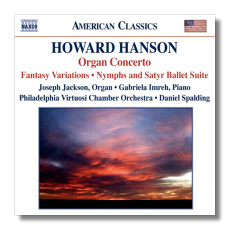
The Internet's Premier Classical Music Source
Related Links
- Hanson Reviews
- Latest Reviews
- More Reviews
-
By Composer
-
Collections
DVD & Blu-ray
Books
Concert Reviews
Articles/Interviews
Software
Audio
Search Amazon
Recommended Links
Site News
 CD Review
CD Review
Howard Hanson

Concertante Works
- Concerto for Organ, Harp, and Strings, Op. 22, #3
- Nymphs and Satyr Ballet Suite
- Fantasy Variations on a Theme of Youth for Piano and Strings
- Serenade for Flute, Harp, and Strings, Op. 35
- Summer Seascape #2 for Viola and Strings
- Pastorale for Oboe, Harp, and Strings
Joseph Jackson, organ
Jacqueline Pollauf, harp
Gabriela Imreh, piano
Andrew Bolotowsky, flute
Adriana Linares, viola
Jonathan Blumenfeld, oboe
Philadelphia Virtuosi Chamber Orchestra/Daniel Spalding
Naxos 8.559251 DDD 61:28
This CD, both useful and enjoyable, collects many of Hanson's shorter concertante works together. These were written over the course of more than five decades, from the Concerto for Organ, Harp, and Strings (1926) to Nymphs and Satyr, written in 1979, which includes important solo parts for clarinet and bassoon.
Hanson (1896-1981) was associated with Rochester, New York, and the Eastman School of Music, which he directed for some forty years. I spent almost a decade studying in Rochester, and I can proudly say that there are many aspects of the city – its dark and mysteriously quiet parks, and tree-lined streets, for example – that sound like Hanson's music. By the 1960s, many dismissed Hanson's unabashedly tonal music as too old-fashioned, like a magazine cover by Norman Rockwell or a painting by Edward Hopper. Too bad. His music creates a world of beauty and Americana at its most positive, where "seldom is heard a discouraging word."
That phrase sums up the Organ Concerto, a beautiful and elegiac work, and completely devoid of organ-like bombast. The Serenade and the Pastorale were composed in the 1940s; the former was a courtship gift for Hanson's wife-to-be, and the latter was dedicated to her after they were married. Hanson based his Fantasy Variations on a Theme of Youth (1951) on a theme he had jotted down while a student at Northwestern University in the 1910s. The Summer Seascape #2 (1965) was inspired by a region in Maine where the composer often spent his summers. Finally, Nymphs and Satyr is drawn largely from earlier works by Hanson: a Fantasy for Clarinet and Chamber Orchestra and a Scherzo for Bassoon and Chamber Orchestra. Hanson frames them with a Prologue and an Epilogue. This was one of Hanson's last completed works.
It would be facile to dismiss Hanson as a mere academic. His music is well-constructed and follows the accepted "rules" very well – never mind that Hanson wrote many of those same rules! – but at the same time it never feels uninspired (or uninspiring!) or workmanlike. Simply put, he knew how to make a listener feel good. He also knew how to challenge musicians without introducing difficulties for difficulty's sake.
Most of the soloists here are associated with one or more Philadelphia-based ensembles. (Blumenfeld, for example, plays oboe for the Philadelphia Orchestra.) The Philadelphia Virtuosi, founded in 1991 by conductor Daniel Spalding, is a fine chamber orchestra, and already has made its mark on CD with an excellent recording of music by George Antheil (Naxos 8.559060). All of these works have been recorded before (with the possible exception of Summer Seascape #2), but Naxos' CD brings them all together under one umbrella, so its utility should be obvious. All of the performances have been giving a caring touch, and are played with the simple eloquence they need. Hanson, a Nebraskan with Swedish roots, would have appreciated the plain-spoken eloquence of these readings. The 2005 recording (made in Philly's First Presbyterian Church) is flattering.
Copyright © 2006, Raymond Tuttle




















